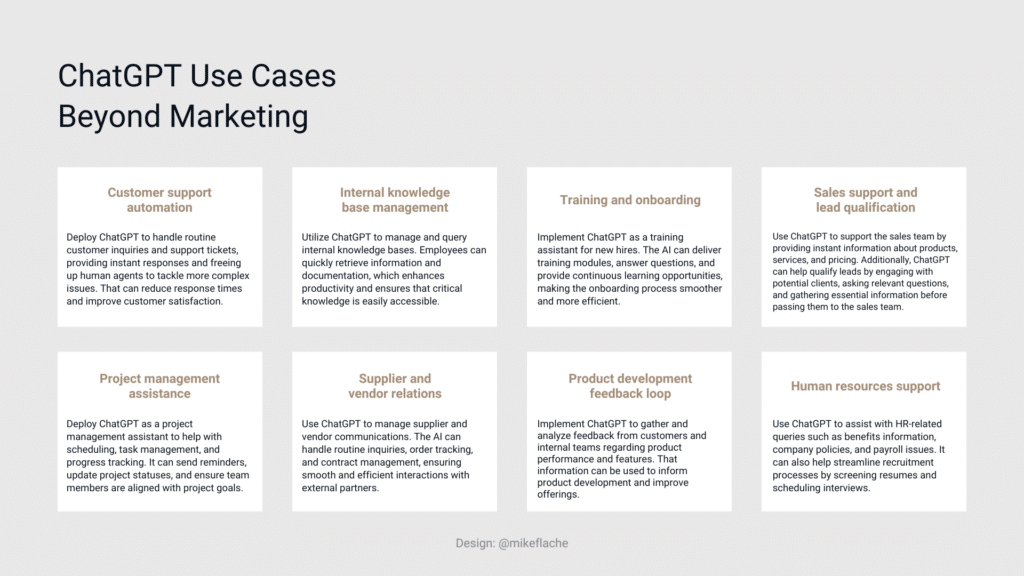Key takeaways
- The new ChatGPT capabilities will certainly excite many technology and AI fans. From an executive’s perspective, these innovations are, in my experience, rather sober.
- At board and management level, there are much more pragmatic issues at stake than the latest technology releases, which are being brought to market at ever shorter intervals.
- The possible use cases of artificial intelligence, in general, and ChatGPT, in particular, are diverse and go far beyond marketing.
In mid-May, OpenAI unveiled its latest highlight: GPT-4o.
There is no doubt that this release has a lot to offer, for example:
- Improved voice interaction – users can ask direct questions and also interrupt answers,
- Differentiated voice styles – voices can be generated in different emotional styles, including singing,
- Optimized visual functionality – questions about photos, including identifying clothing brands, can be answered instantly,
to name just three of many aspects that will have a lasting impact on our business world.
The new possibilities will certainly excite many technology and AI fans. From an executive’s perspective, these innovations are, in my experience, rather sober.
Three key questions that concern decision-makers
- Which ChatGPT functions are actually relevant for our business?
- What use cases, specifically beyond marketing, can be derived from this?
- What value-creation potential can we tap into in these areas?
These questions cannot be answered in general terms. Organizations are at different points in their digital transformation or their AI journey.
However, practice shows that quite a few organizations, especially in traditional industries, are still at the beginning when it comes to artificial intelligence in general.
Here are some figures from the CompTIA IT Industry Outlook 2024 Report:
- 22% of firms are aggressively pursuing the integration of AI across a wide variety of technology products and business workflows
- 33% of firms are engaging in limited implementation of AI
- 45% of firms are still in the exploration phase
This situation underlines that at board and management level, there are much more pragmatic issues at stake than the latest technology releases, which are being brought to market at ever shorter intervals.
Three practical ChatGPT use cases for traditional B2B organizations
In my current discussions, I’m noticing that many decision-makers associate ChatGPT primarily with marketing. I can’t (yet) answer why this is the case.
Even direct questions don’t produce any clear results. I guess that so-called stereotypes have been formed as a result of media coverage and the behavior of input and output when using ChatGPT.
Regardless of the actual reason, I would like to list three practical ChatGPT use cases in this context that go beyond marketing.

1. Customer support and service automation
ChatGPT can be integrated into a B2B organization’s customer support system to answer frequently asked questions, troubleshoot common issues, and respond to customer requests immediately. That can significantly reduce the workload of support agents, allowing teams to focus on complex and high-value tasks.
Specific example: manufacturing
A manufacturing company could use ChatGPT to provide real-time support to customers who need help with product specifications, order status, or technical documentation. That not only increases customer satisfaction but also improves the efficiency and scalability of the support service.
2. Internal knowledge management
B2B organizations often have large amounts of internal knowledge and documentation that need to be managed and made accessible to employees. ChatGPT can serve as an intelligent knowledge base, allowing employees to quickly find information, policies, or best practices without having to dig through extensive manuals or databases.
Specific example: consulting
A large consulting firm could use ChatGPT to help consultants find templates and reports on previous projects or compliance requirements, increasing productivity and ensuring consistent quality of results.
3. Training and onboarding
Onboarding new employees and providing ongoing training can be resource-intensive for B2B organizations. ChatGPT can be used to create interactive training modules, answer new hires’ questions, and provide on-the-job learning support. This personalized training experience can help new hires get up to speed faster and more effectively.
Specific example: IT services
An IT services company could use ChatGPT to guide new technicians through their initial training phase and provide real-time support in troubleshooting, applying company policies, and using tools. That can result in knowledgeable and competent teams.
Final thoughts
The possible use cases of artificial intelligence, in general, and ChatGPT, in particular, are diverse and go far beyond marketing.
In combination with other AI-relevant systems, such as predictive maintenance, undiscovered value creation potential can be tapped.
Regardless of whether an organization is just starting to think about AI or is already more advanced, the core questions for the board and management are the same.

